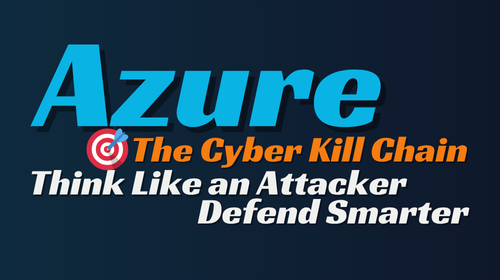- Home
- Security & Compliance
- The Cyber Kill Chain – The Attacker’s Step-by-Step Plan
The Cyber Kill Chain – The Attacker’s Step-by-Step Plan
THE CYBER KILL CHAIN
A strategic, phase-by-phase framework for understanding and neutralizing cyberattacks using the Microsoft Azure security ecosystem.
To effectively defend a digital environment, you must think like an attacker. The Cyber Kill Chain provides this crucial perspective by breaking down a complex attack into a clear, sequential series of steps. This phase-based model is powerful because it reveals that an attack is not a single event, but a campaign. By mapping the comprehensive security tools within the Microsoft Azure ecosystem to each specific phase, we can build a layered defense designed to interrupt and neutralize an attack at any point, long before the final objective is achieved.
The 7 Phases of a Digital Offensive
Reconnaissance
Attacker gathers intelligence on targets, employees, and systems to find vulnerabilities.
Weaponization
A malicious payload (e.g., ransomware) is crafted and paired with an exploit.
Delivery
The weapon is transmitted to the target, often via phishing emails.
Exploitation
The malicious code is triggered, gaining access to the target system.
Installation
Malware installs a persistent backdoor to maintain access.
Command & Control
Attacker establishes remote control over compromised assets.
Actions on Objectives
The attacker's ultimate goal (e.g., data theft) is achieved.
Anatomy of an Attack
Primary Delivery Vectors
The 'Delivery' phase is a crucial chokepoint. The vast majority of attacks begin by preying on human trust, with phishing emails being the overwhelmingly dominant method used to get a weaponized payload through an organization's perimeter defenses.
Common Attacker Objectives
Once an attacker has control, their actions align with their end goal. While disruptive ransomware attacks are highly visible, silent data exfiltration for espionage or future extortion remains a primary driver for sophisticated threat actors.
Breaking the Chain: The Azure Defense Playbook
An attack is a sequence of stages, and a single broken link can neutralize the entire threat. Here is an expanded playbook on how to leverage the Microsoft Security Stack to build a formidable, layered defense at each phase.
Building the Walls: Early Defense
The earliest phases are about limiting exposure and blocking entry. Your goal is to be a hard target and deny the attacker their initial foothold.
- Microsoft Defender for Cloud: Continuously assess your security posture across Azure, hybrid, and multi-cloud environments. Use its Attack Surface Management tools to identify and reduce exposed assets before attackers find them.
- Microsoft Sentinel: Integrate threat intelligence feeds to get early warnings. Sentinel can alert you if your domains or IPs appear in threat actor discussions or are being targeted by known campaigns.
- Microsoft Defender for Office 365: This is your front-line defense against the primary delivery vector. It uses 'Safe Attachments' to sandbox and detonate attachments in a virtual environment and 'Safe Links' to scan URLs at the time of click, blocking access to malicious sites.
Securing the Gates: Breach Prevention
If a weapon gets through, you must prevent it from detonating and establishing a persistent presence. This layer of defense focuses on endpoint and identity security.
- Microsoft Defender for Endpoint: Deploys to your devices (endpoints) and uses next-gen antivirus, Attack Surface Reduction (ASR) rules, and Endpoint Detection and Response (EDR) to block exploits and malicious scripts in real-time.
- Azure AD (Entra ID) Privileged Identity Management (PIM): Enforce the principle of least privilege. PIM ensures users only have administrative rights on a Just-In-Time (JIT) basis, drastically reducing the window for an attacker to create persistent admin accounts.
- Defender for Cloud Vulnerability Management: Regularly scan VMs, containers, and servers for software vulnerabilities and prioritize patching before they can be exploited.
Damage Control: Threat Containment
This is your last line of defense, focused on detecting active breaches, containing them, and preventing the attacker from achieving their goal.
- Azure Firewall & Network Security Groups (NSGs): Implement egress filtering to block outbound traffic to known malicious C2 servers and non-standard ports, severing the attacker's control channel.
- Microsoft Sentinel SOAR: Leverage Security Orchestration, Automation, and Response. Create automated playbooks that, upon detection of a high-severity threat, can instantly isolate a host from the network, disable the compromised user account, and notify the security team.
- Microsoft Purview: Prevent data exfiltration with Data Loss Prevention (DLP) policies. Purview can identify, classify, and block sensitive data from leaving your environment via email, SharePoint, or other vectors, even if an attacker has internal access.

